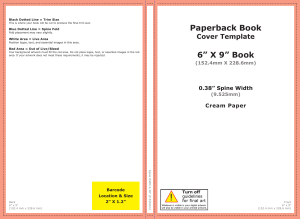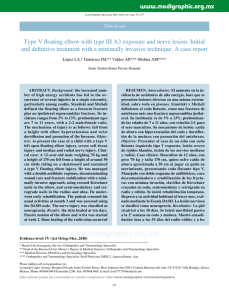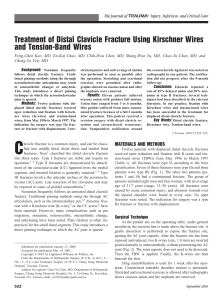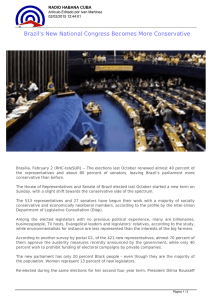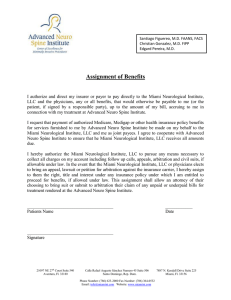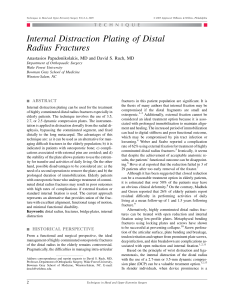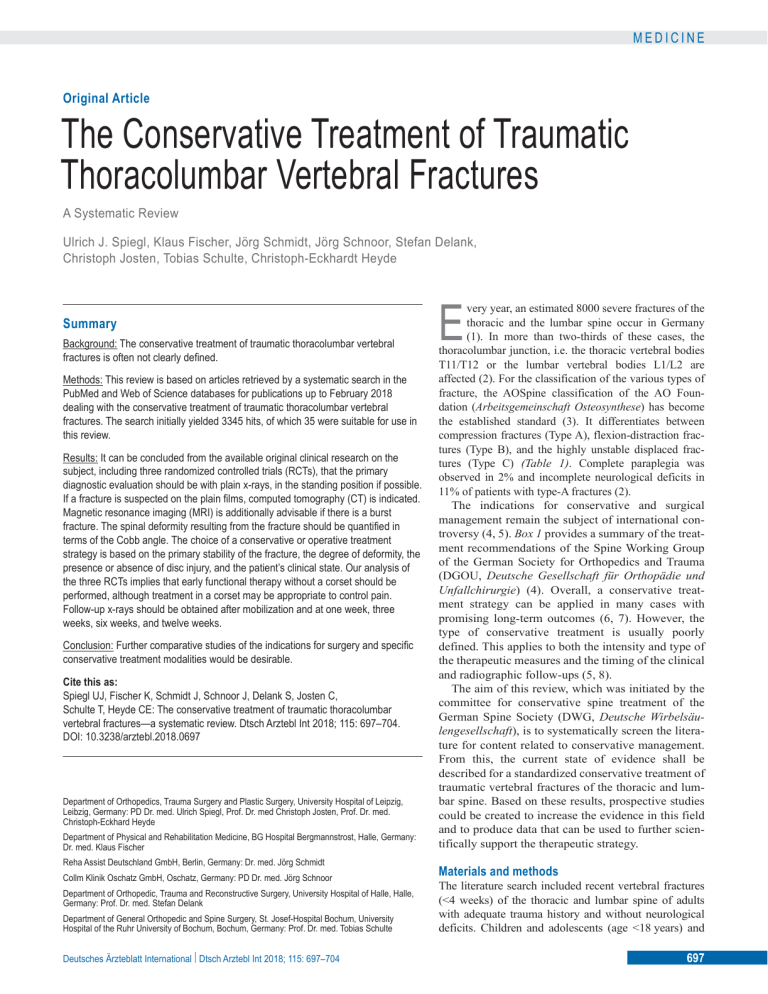
MEDICINE Original Article The Conservative Treatment of Traumatic Thoracolumbar Vertebral Fractures A Systematic Review Ulrich J. Spiegl, Klaus Fischer, Jörg Schmidt, Jörg Schnoor, Stefan Delank, Christoph Josten, Tobias Schulte, Christoph-Eckhardt Heyde Summary Background: The conservative treatment of traumatic thoracolumbar vertebral fractures is often not clearly defined. Methods: This review is based on articles retrieved by a systematic search in the PubMed and Web of Science databases for publications up to February 2018 dealing with the conservative treatment of traumatic thoracolumbar vertebral fractures. The search initially yielded 3345 hits, of which 35 were suitable for use in this review. Results: It can be concluded from the available original clinical research on the subject, including three randomized controlled trials (RCTs), that the primary diagnostic evaluation should be with plain x-rays, in the standing position if possible. If a fracture is suspected on the plain films, computed tomography (CT) is indicated. Magnetic resonance imaging (MRI) is additionally advisable if there is a burst fracture. The spinal deformity resulting from the fracture should be quantified in terms of the Cobb angle. The choice of a conservative or operative treatment strategy is based on the primary stability of the fracture, the degree of deformity, the presence or absence of disc injury, and the patient’s clinical state. Our analysis of the three RCTs implies that early functional therapy without a corset should be performed, although treatment in a corset may be appropriate to control pain. Follow-up x-rays should be obtained after mobilization and at one week, three weeks, six weeks, and twelve weeks. Conclusion: Further comparative studies of the indications for surgery and specific conservative treatment modalities would be desirable. Cite this as: Spiegl UJ, Fischer K, Schmidt J, Schnoor J, Delank S, Josten C, Schulte T, Heyde CE: The conservative treatment of traumatic thoracolumbar vertebral fractures—a systematic review. Dtsch Arztebl Int 2018; 115: 697–704. DOI: 10.3238/arztebl.2018.0697 Department of Orthopedics, Trauma Surgery and Plastic Surgery, University Hospital of Leipzig, Leibzig, Germany: PD Dr. med. Ulrich Spiegl, Prof. Dr. med Christoph Josten, Prof. Dr. med. Christoph-Eckhard Heyde Department of Physical and Rehabilitation Medicine, BG Hospital Bergmannstrost, Halle, Germany: Dr. med. Klaus Fischer Reha Assist Deutschland GmbH, Berlin, Germany: Dr. med. Jörg Schmidt Collm Klinik Oschatz GmbH, Oschatz, Germany: PD Dr. med. Jörg Schnoor Department of Orthopedic, Trauma and Reconstructive Surgery, University Hospital of Halle, Halle, Germany: Prof. Dr. med. Stefan Delank Department of General Orthopedic and Spine Surgery, St. Josef-Hospital Bochum, University Hospital of the Ruhr University of Bochum, Bochum, Germany: Prof. Dr. med. Tobias Schulte Deutsches Ärzteblatt International | Dtsch Arztebl Int 2018; 115: 697–704 E very year, an estimated 8000 severe fractures of the thoracic and the lumbar spine occur in Germany (1). In more than two-thirds of these cases, the thoracolumbar junction, i.e. the thoracic vertebral bodies T11/T12 or the lumbar vertebral bodies L1/L2 are affected (2). For the classification of the various types of fracture, the AOSpine classification of the AO Foundation (Arbeitsgemeinschaft Osteosynthese) has become the established standard (3). It differentiates between compression fractures (Type A), flexion-distraction fractures (Type B), and the highly unstable displaced fractures (Type C) (Table 1). Complete paraplegia was observed in 2% and incomplete neurological deficits in 11% of patients with type-A fractures (2). The indications for conservative and surgical management remain the subject of international controversy (4, 5). Box 1 provides a summary of the treatment recommendations of the Spine Working Group of the German Society for Orthopedics and Trauma (DGOU, Deutsche Gesellschaft für Orthopädie und Unfallchirurgie) (4). Overall, a conservative treatment strategy can be applied in many cases with promising long-term outcomes (6, 7). However, the type of conservative treatment is usually poorly defined. This applies to both the intensity and type of the therapeutic measures and the timing of the clinical and radiographic follow-ups (5, 8). The aim of this review, which was initiated by the committee for conservative spine treatment of the German Spine Society (DWG, Deutsche Wirbelsäulengesellschaft), is to systematically screen the literature for content related to conservative management. From this, the current state of evidence shall be described for a standardized conservative treatment of traumatic vertebral fractures of the thoracic and lumbar spine. Based on these results, prospective studies could be created to increase the evidence in this field and to produce data that can be used to further scientifically support the therapeutic strategy. Materials and methods The literature search included recent vertebral fractures (<4 weeks) of the thoracic and lumbar spine of adults with adequate trauma history and without neurological deficits. Children and adolescents (age <18 years) and 697 MEDICINE TABLE 1 AOSpine thoracolumbar vertebral fracture classification system Type Subtype Nomenclature Definition Frequency (%) A A0 Process fracture/edema ● No motion segment affected ● No posterior vertebral wall involvement 57.8 A1 Endplate fracture ● One motion segment affected ● No posterior vertebral wall involvement 7.5*3 A2 Split fracture ● Two motion segment affected ● No posterior vertebral wall involvement 2.7 A3 Incomplete burst fracture ● One motion segment affected ● With posterior vertebral wall involvement 20.8*4 A4 Burst split/ complete burst fracture ● Two motion segment affected ● With posterior vertebral wall involvement 33.8*4 B1 Chance fracture ● Monosegmental osseous distraction B2 Flexion injury ● Injury to the posterior ligamentous complex B3 Extension injury ● Disruption of anterior tension band B C C Displacement/translation injury ● Severe displacement 24.3 n/a*2 18.5*5 0.9 17.9 *1 14.7*1 The definition of the AOSpine classification system according to Vaccaro et al. is stated (3) which builds on the Magerl classification system (e20). The respective fracture frequency is stated. This is based on the Magerl classification (2). *1 The definition of type C fractures varies between the Magerl classification and the AOSpine classification. *2 Process fractures and fracture edema are not mentioned in the Magerl classification. Thus, the proportion of theses fractures is not reported in the literature. *3 Since Reinhold et al. (2) included only inpatients, it can be expected that A1 fractures are underrepresented. *4 The relative frequency of incomplete burst fractures is based on a study by Merkel et al. (e21). *5 B1 and B2 fractures are differently defined in the Magerl classification and the AOSpine classification; therefore, the B1 and B2 fractures were combined. The frequencies of types and the frequencies of subtypes are not fully identical due to a lack of subtype classification in 9% of patients (2). n/a, not available the elderly (age >65 years) with likely concomitant osteopenia/osteoporosis are not within the scope of this review and need to be analyzed separately. Furthermore, patients with fractures after non-adequate trauma (trivial falls from tripping) are not included in this review. A systematic search of the literature was performed by two of the authors (UJS, C-EH), including all articles until 2/2/2018. In each case, the two databases PubMed and Web of Science Core Collection were considered and searched. Since data collection had already been completed at the time of PROSPERO registration, this review could not be registered with PROSPERO. Using the PICO scheme (9), the following review questions were defined: ● Do patients with non-osteoporotic traumatic thoracolumbar vertebral fractures achieve better clinical outcomes after operative treatment or conservative treatment? ● Is it possible to recommend some treatments more than others? The following search terms were used: (“vertebral body fracture” OR “vertebral fracture” OR “spine fracture” OR “lumbar spine fracture” OR “thoracic spine fracture”) AND (“nonoperative treatment” OR “conservative treatment” OR “orthosis” OR “brace” OR “physiotherapy” OR “analgesia” OR “radiography”) AND (“English” OR “German”) NOT “case reports” NOT “reviews” NOT “osteoporosis” NOT “osteoporotic” NOT “cervical” NOT “sacral” NOT “odontoid”. 698 Subsequently, all relevant original articles were analyzed based on their levels of evidence and their appropriate conclusions. Here, the following topic areas were defined: ● Diagnostic assessment of vertebral fractures (primary diagnosis and follow-ups) ● Aids/orthoses ● Pharmacological treatment ● Non-pharmacological treatments ● Alternative medicine treatments. Results and discussion Altogether, 3345 abstracts were retrieved from the literature search (Figure). Of these, 3170 articles were excluded based on abstract or title. Most of the excluded studies were animal experimental or biomechanical studies or articles which were not original articles or investigated other pathologies or exclusively evaluated surgical procedures or fractures in the elderly. Altogether, 175 articles were read completely. Of these, further 140 articles were excluded because the conservative treatment provided was not adequately defined or because conservative methods were used that are no longer up to date (for example, bed rest for several weeks). Altogether, 3310 articles were excluded (Figure). Levels of evidence were defined as described by Bassler and Antes (10) (Box 2). All 35 remaining original articles, which covered the period from 1969 to 2018, are summarized in Table 2. Deutsches Ärzteblatt International | Dtsch Arztebl Int 2018; 115: 697–704 MEDICINE Initial work-up High-velocity trauma patients should undergo a polytrauma spiral computed tomography (CT) scan, covering the entire spine, as recommended by the clinical Guideline on the Treatment of Polytrauma/Severe Injuries (11) of the Association of Scientific Medical Societies in Germany (AWMF, Arbeitsgemeinschaft der Wissenschaftlichen Medizinischen Fachgesellschaften). Clinical examination alone cannot conclusively rule out fractures (12, 13). In patients who sustained injuries during lower-velocity type accidents, conventional 2-view radiographs are indicated, subject to the clinical findings. If not too painful, these radiographs should be obtained in a standing position so that the true extent of the kyphotic deformity can be assessed. Mehta et al. (14) demonstrated a relevant increase in bisegmental kyphosis angles (sagittal Cobb angle) on standing radiographs compared to supine radiographs. The bisegmental kyphosis angle was on standing radiographs on average 7° larger compared to supine films. When evaluating local kyphosis, preference should be given to the bisegmental kyphosis angle determined on conventional radiographs, as it offers the best interobserver agreement and predictive value (15–18). Local post-traumatic kyphosis of more than 20° is frequently associated with posterior ligamentous complex injury (19). In case a vertebral fracture was detected or could not be reliably ruled out, an additional computed tomography (CT) scan of the suspicious segment should be obtained (20–22). In fractures of the spine, the diagnostic performance of low-dose CT was found to be comparable to that of standarddose CT, with a considerable reduction in radiation dose (23). Magnetic resonance imaging (MRI) is recommended to accurately assess injury severity in burst fractures, in particular to correctly assess the posterior ligamentous complex (PLC) and intervertebral disc lesions (24–31). Pizones et al. (24) reported that an injury to the posterior ligamentous complex can be detected with a sensitivity of 91% and a specificity of 100%. Besides providing insight into the status of the posterior ligamentous complex and ruling out potential intervertebral disc damage, MRI allows to assess the extent of intervertebral disc injury (31). By contrast, Vaccaro et al. (29) found a lower sensitivity (range, depending on anatomical structure: 79–91%) and specificity (range: 38–67%), but nevertheless recommended MRI to complement the clinical findings as well as findings of other radiographic investigations to rule out or confirm a lesion of the posterior portion of the spine. Furthermore, the following risk factors for secondary sintering after conservative treatment were identified based on MRI findings: ● Lesion of the anterior longitudinal ligament ● Cranial endplate lesions with involvement of the intervertebral disc ● Marked vertebral body edema (32). Furthermore, secondary loss of regional sagittal alignment was largely attributable to the interverteDeutsches Ärzteblatt International | Dtsch Arztebl Int 2018; 115: 697–704 BOX 1 Indications for conservative treatment and operative treatment ● Conservative treatment – Type A0 fractures – Type A1 fractures with acceptable kyphotic deformity – Type A2 fractures without relevant disc injury or fracture displacement – Lack of informed consent for surgery ● Surgery – Neurological deficit – Type C and Type B fractures – Kyphotic deformity of >15–20° (compared to normal position – Scoliotic deformity >10° – Immobilization in case of treatment-resistant pain – Relevant traumatic disc damage bral disc (33, 34). Complementing standard MRI sequences, susceptibility-weighted MRI allowed improved fracture detection not only of recent fractures, but also and especially of non-healed fractures (33). Thus, accurate evaluation of injury severity can only be done after complete diagnostic work-up. This might include additional MRI to identify relevant intervertebral disc injuries and to distinguish between type A and type B injuries. The available evidence is insufficient to draw conclusions about the need for and significance of special radiographs, such as hypomochlion radiographs (lateral radiograph in supine position with a roll, serving as a hypomochlion, below the vertebral body to be assessed in order to determine the flexibility and stability in the affected segment of the spine), flexion and extension views, and whole-spine radiographs; FIGURE Medline + Web of Science Core (n = 3345) 3170 abstracts were eliminated Requested full-text articles fulfilling the inclusion criteria (n = 175) Excluded full-text articles (n = 140) Included publications (n = 35) (Table 1) Flow chart of the systematic literature review 699 MEDICINE BOX 2 Hierarchical levels of external evidence Ia: Evidence from meta-analyses of randomized controlled trials Ib: Evidence from at least one randomized controlled trial IIa: Evidence from at least one well-designed controlled study without randomization IIb: Evidence from one well-designed quasi-experimental study III: Evidence from well-designed, non-experimental descriptive studies (for example comparative studies, correlation studies, case–control studies) IV: Evidence from reports/opinions of experts, consensus conferences and/or clinical experiences of recognized authorities consequently, these special investigations are only performed in individual cases. For example, hypomochlion radiographs can be indicated during the first four weeks in patients with regional sagittal kyphosis of more than 10° to 15° to determine the potential for correction. By contrast, functional radiographs play a role especially in the evaluation of the stability of fractures of the upper and middle cervical spine. Whole-spine radiographs are indicated particularly in patients with serial vertebral fractures or pre-existing deformities and degenerative changes (35). Diagnostic follow-ups Regional conventional standing 2-view radiographs should be obtained for radiographic follow-up. With regard to the timing of follow-up examinations, the available evidence is scarce. However, Shen et al. (36) demonstrated a high rate of treatment failure (19%) in type A fractures without neurological deficits. They identified increased posttraumatic interpedicular distances between two vertebral bodies on anterior–posterior radiographs and severe initial pain as risk factors for failure of treatment and recommended clinical and radiographic follow-ups at close intervals for patients undergoing conservative treatment. Overall, secondary sintering can be expected to occur over a period of at least 3 months (37, 38). Interestingly, sponenous reduction of fracture-related spinal stenosis of almost 10% was seen in patients who underwent conservative treatment (39). The available evidence does not allow to draw a conclusive recommendation regarding the best timing of radiographic follow-ups. In our view, follow-up radiographs should be obtained after primary mobilization (3–4 days), after 1, 3, 6 and 12 weeks as well as 700 with any increase in symptoms, in keeping with the recommendation for conservatively treated extremity fractures. The radiographic work-up is summarized in Box 3. Management Aids and orthoses Three randomized controlled trials evaluated the need for adjunctive orthotic treatment; thus, for this question the highest level of evidence is available among the investigated questions related to conservative fracture management (40, e1, e2). Bailey et al. (40) used the following inclusion criteria: recent burst fractures of the type A3/A4 of thoracic vertebra 10 (T10) to lumbar vertebra 2 (L2), bisegmental kyphosis lower than 35° and age between 18 and 60 years. The patients were randomly assigned to the treatment groups, 47 without orthosis and 49 with orthosis. The corset orthosis was worn for 10 weeks. The primary outcome parameter was the Roland Morris Disability Questionnaire (RMDQ) assessed at 3 months after the injury (e3). Secondary outcome parameters included the SF-36 score, VAS (visual analog scale) pain score, patient satisfaction, and bisegmental kyphosis at weeks 6 and 12 as well as months 6, 12 and 24. The follow-up rates were 95% after 3 months, 85% after 1 year and 70% after 2 years. No statistically significant differences were found between the two treatment groups, neither for the primary nor for the secondary outcome parameters, at any point in time during the follow-up period. Stadhouder et al. (e1) included patients with recent compression fractures (A1–A4) with <50% loss of height of the anterior column and <30% stenosis of the spinal canal of the entire thoracic and lumbar spine, and conservative treatment. The age limits were 18 and 80 years. The primary outcome parameter was the bisegmental kyphosis angle. The secondary outcome parameters were the VAS pain score and the Oswestry Disability Index (ODI) (e4). Follow-up visits were scheduled at 6 and 12 weeks, 6 and 12 months, and at least 2 years after the injury. Altogether, 133 patients were included. Of these, 29 were treated with physiotherapy alone, 38 plus a corset orthosis, 27 and 39 patients plus a plaster of Paris cast for 6 and 12 weeks, respectively. The follow-up rate at the time of the last follow-up visit, which occurred after 7 years on average, was 75%. Overall, no differences were found for the primary outcome parameter, the sagittal alignment, between any of the treatment groups. Management without corset orthosis was perceived as the most convenient treatment. Patient treated with a plaster of Paris cast experienced clinical disadvantages compared to the other treatment groups. In addition, a minor, but statistically significant reduction in spine-associated limitations was found for the orthosis group compared to the group without orthosis. A critical point, however, is the inclusion age of 80 years, as it implies that most likely patients with osteoporotic fractures were included in the study. This Deutsches Ärzteblatt International | Dtsch Arztebl Int 2018; 115: 697–704 MEDICINE TABLE 2 List of all included studies and their key messages Article with study design [level of evidence] Question Key messages Inaba et al. 2011 (12) Venkatesan et al. 2012 (13) Cohort [III] Case series [IV] Is clinical examination alone sufficient to exclude or confirm suspected vertebral fracture? ● In patients with high-velocity trauma, clinical examination alone is not sufficient to exclude or confirm suspected vertebral fracture. Mehta et al. 2004 (14) Cohort [IIa] Radiographic positioning ● Bisegmental kyphosis angle (sagittal Cobb angle) significantly higher in standing position Kuklo et al. 2001 (15) Street et al. 2009 (16) Jiang et al. 2012 (17) Ulmar et al. 2010 (18) Comparison [III] Comparison [III] Comparison [III] Comparison [III] Determining regional malpositioning ● Best reliability by measuring bisegmental kyphosis angle with best inter- and intraobserver reliability ● Highest reliability with conventional radiography Hiyama et al. 2015 (19) Case series [IV] Radiographic evaluation of the posterior ligament complex ● Signs of injury to the posterior column include: ○ local kyphosis >20° ○ increased supraspinous distance Campbell et al. 1995 (20) Dai et al. 2008 (21) Ballock et al. 1992 (22) Cohort [III] Comparison [III] Comparison [III] Is conventional radiography sufficient for assessment of stability? ● Good fracture verification, but limited fracture classification ● In comparison with CT, the negative predictive value for unstable fractures was 62% ● Consequently, a CT scan is required Lee et al. 2017 (23) Case–control [III] Comparison between low-dose CT and standard-dose CT ● Comparable diagnostic accuracy with reduction of radiation dose by 47–69% Pizones et al. 2011 (24) Lee et al. 2000 (25) Petersilge et al. 1995 (26) Haba et al. 2003 (27) Terk et al. 1997 (28) Vaccaro et al. 2009 (29) Cohort [III] Comparison [III] Cohort [IV] Comparison [III] Cohort [III] Comparison [III] Significance of MRI for posterior ligament complex evaluation ● Accurate evaluation of the posterior column with differences in sensitivity (85–91%) and specificity (56–100%) ● Detection of posterior column lesions not detected with conventional radiography and CT in 19% of cases Winklhofer et al. 2013 (30) Oner et al. 1999 (31) Comparison [IV] Case series [IV] Significance of MRI for primary fracture diagnosis ● MRI allows assessment of extent of intervertebral disc damage and assessment of disc protrusion into the fracture gap. ● Following MRI, fracture reclassification was required in 31% of patients (upgrading in 28%). Jun et al. 2015 (32) Case series [IV] MRI risk factors for secondary sintering after conservative treatment ● Injury to the anterior longitudinal ligament ● Cranial endplate injury with involvement of the disc ● Marked edema of the vertebral body Böker et al. 2018 (33) Comparison [III] Diagnostic accuracy of susceptibility-weighted MRI ● More accurate in the evaluation of vertebral fractures, especially non-healing fractures Shen et al. 2015 (36) Cohort [III] Risk factors for failure of conservative treatment ● Risk factors for type A fractures: ○ Increased interpedicular distance between two vertebral bodies ○ High initial VAS pain scores Alanay et al. 2004 (37) Loew et al. 1992 (38) Cohort [III] Cohort [III] Period during which secondary sintering can be expected ● Secondary sintering was observed for up to 3 months. Dai 2001 (39) Case series [IV] Development of posttraumatic spinal stenosis ● Extent of spinal stenosis is diminished after conservative treatment by 8.5%. Bailey et al. 2014 (40) Stadhoulder et al. 2009 (e1) Shamji et al. 2014 (e2) Karjalainen et al. 1991 (e6) Ohana et al. 2000 (e7) RCT [Ib] RCT [Ib] RCT [IIa] Case–control [III] Case–control [III] Comparison of management with or without orthosis ● Significantly shorter inpatient stay without corset orthosis ● No clinical or radiographic difference after treatment with or without orthosis Cha et al. 2013 (e10) Kürschner et al. 1980 (e11) Melzer et al. 1974 (e12) Andersen und Horlyck 1969 (e13) Case–control [III] Case series Case series [IV] Case series [IV] Advantages and disadvantages of early mobilization ● Lower complication rate with early mobilization ● Better outcomes after early mobilization ● Early mobilization shortens length of inpatient stay ● No negative effect on alignment Cohort, cohort study; comparison, comparison study; case–control, case–control study; RCT, randomized controlled trial, CT, computed tomography; MRI, magnetic resonance imaging; VAS, visual analog scale Deutsches Ärzteblatt International | Dtsch Arztebl Int 2018; 115: 697–704 701 MEDICINE BOX 3 BOX 4 Diagnostic procedure for traumatic vertebral fractures of the thoracic and lumbar spine in patients with normal bone density WHO’s three-step Pain Relief Ladder * ● Step 1 ● CT scan in case of high-velocity trauma in keeping with clinical (S3) guideline ● Step 2 Polytrauma ● Otherwise, primarily conventional 2-view radiography ● Conventional radiography, if possible, in standing position ● If fracture is suspected, a computed tomography (CT) scan should be – Non-opioid analgesics – Weak opioid analgesics ● Step 3 – Strong opioid analgesics * Optionally, muscle relaxants can be added at each of the 3 steps performed for more accurate evaluation of fracture morphology ● Follow-up radiographs should be obtained after mobilization (3–4 days) and at weeks 1, 3, 6, and 12. ● In case of burst fractures, magnetic resonance imaging (MRI) is indicated to rule out a B component and to evaluate the intervertebral disc damage ● Determining the bisegmental kyphosis angle on conventional radiographs offers the highest interobserver agreement view is supported by the finding that some patients sustained fractures as the result of low-velocity traumas. This point is very relevant because, in contrast to patients with normal bone density, it is assumed that patients undergoing conservative treatment for osteoporotic vertebral fractures benefit from corset treatment due to a muscle-stimulating effect potentially associated with wearing the orthosis (e5). Shamji et. al. (e2) reported about patients with recent A3 or A4 fractures of T10 to L4. The primary outcome parameter was the bisegmental kyphosis angle at 6 months follow-up. Secondary outcome parameters were the VAS pain score, ODI score and SF-36 score at 6 months follow-up. Altogether, 23 patients were included. All 23 patients were re-evaluated at 6 months follow-up. Looking at all outcome parameters, no statistically significant or clinically relevant differences were found between patients with and without orthosis. This is in line with the findings of two level III studies which found no clinical or radiographic advantages of orthotic treatment (e6, e7). In summary, based on the available evidence, orthotic treatment is not indicated as part of the conservative management of fractures of the thoracic and lumbar spine in patients with normal bone density. However, in individual cases, treatment with a corset orthosis can be a beneficial component of conservative fracture management due to its analgesic effect. Further randomized multicenter studies with selective inclusion of traumatic fractures and comparable types of fracture are needed to re-evaluate the usefulness of orthotic treatment. Here, sub-analyses of matched-pair data taking into account fracture type and fracture location would be advantageous. 702 Physiotherapy and manual therapy The need for adjunctive physiotherapy is generally emphasized, but studies comparing specific types of treatment have not been performed. Even widely recognized aftercare recommendations provide no explicit information about the frequency of treatment and specific types of treatment (e8, e9). In summary, no evidence-based studies evaluating the indication for and efficacy of adjunctive treatments in patients with vertebral fractures of the thoracic or lumbar spine are available. Nevertheless, there are some interesting aspects which could be adopted, although with reservation. For example, Cha et al. (e10) found in their prospective randomized study that in patients with osteoporotic vertebral fractures the complication rate is significantly lower if adjunctive physiotherapy is started early—with comparable degrees of pain and similar secondary sintering. From this finding for osteoporotic fractures it can be concluded that a similar positive effect of starting adjunctive physiotherapy at an early point can be expected for non-osteoporotic fractures as well. In addition, early functional treatment significantly reduced the length of inpatient stay without negative effects on alignment (e11–e13). Here, isometric training appears to result in an increase in muscle size comparable to that achieved with flexion exercises, while offering the advantage of less forces acting on the fracture (e14). With little evidence available, there is no indication for manual therapy in the management of recent fractures. Likewise, there is a lack of evidence regarding the usefulness of physical therapy, such as hot and cold applications, ultrasound, electrotherapy, and alternative types of treatment, such as magnetic field therapy and acupuncture. Pharmacotherapy Very little evidence is available with regard to the management of pain in patients with non-osteoporotic vertebral fractures. Our systematic search of the literature identified no article dealing with the aspect of Deutsches Ärzteblatt International | Dtsch Arztebl Int 2018; 115: 697–704 MEDICINE analgesic treatment which could be included in this review. Consequently, it is not possible to make any systematic review–based recommendations for a specific analgesic treatment as a component of the conservative management of traumatic vertebral fractures of the thoracic and lumbar spine. Therefore, we recommend—taking patient age, concomitant diseases and contraindications into account—to follow the pharmacological pain management for osteoporotic vertebral fractures (e15) and the World Health Organization’s (WHO) three-step Pain Relief Ladder (Box 4) (e16) when providing pharmacological pain relief to this patient population. Non-opioid analgesics (NOPA) This group includes nonsteroidal anti-inflammatory drugs (NSAIDs), coxibs and metamizole (Step 1, WHO Pain Relief Ladder). Because of their anti-inflammatory potential, initially drugs of the NSAID group are selected. In case of intolerance or contraindications, the off-label use of coxibs may be considered. Data on the use of metamizole is still scarce, even though the substance has been administered over decades, especially in Germany, and proven its effectiveness for pain relief (e17). Opioids In patients with severe pain or inadequate response to NOPAs, weak opioid analgesics (tramadol, tilidine/naloxone; Step 2, WHO Pain Relief Ladder) can be used in addition (e15). In order to reduce the risk of addiction, the use of sustained-release formulations, administered according to a fixed schedule, is advisable (e18). In patients with persisting or increasing severe pain, the use of strong opioids may be considered (Step 3, WHO Pain Relief Ladder). All opioids share a sedating effect, which, in combination with dizziness, may increase the risk of falling. Muscle relaxants Muscle relaxants, in combination with other analgesics, can be used as an adjuvant in pain management to facilitate opioid weaning. Due to their side-effect profile, muscle relaxants should not be used for longer than 2 weeks (e19). Conclusion The available evidence on the conservative treatment of traumatic vertebral fractures of the thoracic and lumbar spine is scant. In the future, further studies in all areas of conservative fracture treatment are urgently needed and considered highly desirable. This includes prospective comparative studies on ● Physiotherapeutic strategies, such as density and contents of treatments ● Duration and extent of restrictions (lifting heavy loads) ● Types of analgesia and their advantages and disadvantages ● Timing and frequency of follow-up radiographs with regard to potential therapeutic consequences. Deutsches Ärzteblatt International | Dtsch Arztebl Int 2018; 115: 697–704 Key messages ● Use conventional radiography for primary assessment ● If fracture is suspected, a computed tomography (CT) scan is indicated. ● In case of burst fractures (incomplete and complete), magnetic resonance imaging (MRI) is recommended. ● Conservative management should consist of early functional treatment without corset orthosis. ● In individual cases, orthotic treatment can be indicated because of its analgesic effect. ● Follow-up standing radiographs should be obtained after mobilization and at weeks 1, 3, 6, and 12 of follow-up. Conflict of interest statement Prof. Heyde received consulting fees from Medacta International. Furthermore, he received funding in a third-party funding account from Medacta International. Prof. Delank, Dr. Fischer, Dr. Schmidt, Prof. Josten, Dr. Schnoor, Prof. Schulte, and Dr. Spiegl declare that no conflict of interest exists. Manuscript received on 15 May 2018; revised version accepted on 5 September 2018 Translated from the original German by Ralf Thoene, MD. References 1. Buhren V: Injuries to the thoracic and lumbar spine. Unfallchirurg 2003; 106: 55–68. 2. Reinhold M, Knop C, Beisse R, et al.: Operative treatment of traumatic fractures of the thoracic and lumbar spinal column. Part I: epidemiology. Unfallchirurg 2009; 112: 33–42. 3. Vaccaro AR, Oner C, Kepler CK, et al.: AOSpine thoracolumbar spine injury classification system: fracture description, neurological status, and key modifiers. Spine 2013; 38: 2028–37. 4. Verheyden AP, Spiegl UJ, Ekkerlein H, et al.: Treatment of fractures of the thoracolumbar spine: recommendations of the spine section of the German Society for Orthopaedics and Trauma (DGOU). Global Spine J 2018; 8(2 Suppl): 34–45. 5. Spiegl UJ, Josten C, Devitt BM, Heyde CE: Incomplete burst fractures of the thoracolumbar spine: a review of literature. Eur Spine J 2017; 12: 3187–98. 6. Weinstein JN, Collalto P, Lehmann TR: Long-term follow-up of nonoperatively treated thoracolumbar spine fractures. J Orthop Trauma 1987; 1: 152–9. 7. Moller A, Hasserius R, Redlund-Johnell I, Ohlin A, Karlsson MK: Nonoperatively treated burst fractures of the thoracic and lumbar spine in adults: a 23– to 41-year follow-up. Spine J 2007; 7: 701–7. 8. Giangregorio LM, Macintyre NJ, Thabane L, Skidmore CJ, Papaioannou A: Exercise for improving outcomes after osteoporotic vertebral fracture. Cochrane Database Syst Rev 2013; 1: CD008618. 9. Farrugia P, Petrisor BA, Farrokhyar F, Bhandari M: Practical tips for surgical research: Research questions, hypotheses and objectives. Can J Surg. 2010; 53: 278–81. 10. Bassler D, Antes G: Wie erhalte ich Antworten auf meine Fragen? In: Kunz R, Ollenschläger G, Raspe H, Jonitz G, Kolkmann FW: Lehrbuch Evidenzbasierte Medizin in Klinik und Praxis. Schriftenreihe Hans Neuffer-Stiftung. Köln: Deutscher Ärzte-Verlag 2000. 11. S3-Leitlinie Polytrauma/Schwerverletzten-Behandlung. www.awmf.org/ uploads/tx_szleitlinien/012–019l_S3_Polytrauma_SchwerverletztenBehandlung_2017–08.pdf (last accessed on 27 September 2018). 12. Inaba K, DuBose JJ, Barmparas G, et al.: Clinical examination is insufficient to rule out thoracolumbar spine injuries. J Trauma 2011; 70: 174–9. 13. Venkatesan M, Fong A, Sell PJ: CT scanning reduces the risk of missing a fracture of the thoracolumbar spine. Bone Joint Surg Br 2012; 94: 1097–100. 703 MEDICINE 14. Mehta JS, Reed MR, McVie JL, Sanderson PL: Weight-bearing radiographs in thoracolumbar fractures: do they influence management? Spine 2004; 29: 564–7. 15. Kuklo TR, Polly DW, Owens BD, Zeidman SM, Chang AS, Klemme WR: Measurement of thoracic and lumbar fracture kyphosis: evaluation of intraobserver, interobserver, and technique variability. Spine 2001; 26: 61–5. 16. Street J, Lenehan B, Albietz J, et al.: Intraobserver and interobserver reliabilty of measures of kyphosis in thoracolumbar fractures. Spine 2009; 9: 464–9. 17. Jiang SD, Wu QZ, Lan SH, Dai LY: Reliability of the measurement of thoracolumbar burst fracture kyphosis with Cobb angle, Gardner angle, and sagittal index. Arch Orthop Trauma Surg 2012; 132: 221–5. 18. Ulmar B, Guhring M, Schmalzle T, Weise K, Badke A, Brunner A: Interand intra-observer reliability of the Cobb angle in the measurement of vertebral, local and segmental kyphosis of traumatic lumbar spine fractures in the lateral X-ray. Arch Orthop Trauma Surg 2010; 130: 1533–8. 19. Hiyama A, Watanabe M, Katoh H, Sato M, Nagai T, Mochida J: Relationships between posterior ligamentous complex injury and radiographic parameters in patients with thoracolumbar burst fractures. Injury 2015; 46: 392–8. 20. Campbell SE, Phillips CD, Dubovsky E, Cail WS, Omary RA: The value of CT in determining potential instability of simple wedge-compression fractures of the lumbar spine. AJNR Am J Neuroradiol 1995; 16: 1385–92. 21. Dai LY, Wang XY, Jiang LS, Jiang SD, Xu HZ: Plain radiography versus computed tomography scans in the diagnosis and management of thoracolumbar burst fractures. Spine 2008; 33: E548–52. 22. Ballock RT, Mackersie R, Abitbol JJ, Cervilla V, Resnick D, Garfin SR: Can burst fractures be predicted from plain radiographs? J Bone Joint Surg Br 1992; 74: 147–50. 23. Lee SH, Yun SJ, Kim DH, Jo HH, Song JG, Park YS: Diagnostic usefulness of low-dose lumbar multi-detector CT with iterative reconstruction in trauma patients: acomparison with standard-dose CT. Br J Radiol 2017; 90: 20170181. 24. Pizones J, Izquierdo E, Alvarez P, et al.: Impact of magnetic resonance imaging on decision making for thoracolumbar traumatic fracture diagnosis and treatment. Eur Spine J 2011; 20 Suppl 3: 390–6. 25. Lee HM, Kim HS, Kim DJ, Suk KS, Park JO, Kim NH: Reliability of magnetic resonance imaging in detecting posterior ligament complex injury in thoracolumbar spinal fractures. Spine 2000; 25: 2079–84. 26. Petersilge CA, Pathria MN, Emery SE, Masaryk TJ: Thoracolumbar burst fractures: evaluation with MR imaging. Radiology 1995; 194: 49–54. 27. Haba H, Taneichi H, Kotani Y, et al.: Diagnostic accuracy of magnetic resonance imaging for detecting posterior ligamentous complex injury associated with thoracic and lumbar fractures. J Neurosurg 2003; 99: 20–6. 704 28. Terk MR, Hume-Neal M, Fraipont M, Ahmadi J, Colletti PM: Injury of the posterior ligament complex in patients with acute spinal trauma: evaluation by MR imaging. AJR Am J Roentgenol 1997; 168: 1481–6. 29. Vaccaro AR, Rihn JA, Saravanja D, et al.: Injury of the posterior ligamentous complex of the thoracolumbar spine: a prospective evaluation of the diagnostic accuracy of magnetic resonance imaging. Spine 2009; 34: E841–7. 30. Winklhofer S, Thekkumthala-Sommer M, Schmidt D, et al.: Magnetic resonance imaging frequently changes classification of acute traumatic thoracolumbar spine injuries. Skeletal Radiol 2013; 42: 779–86. 31. Oner FC, vd Rijt RH, Ramos LM, Groen GJ, Dhert WJ, Verbout AJ: Correlation of MR images of disc injuries with anatomic sections in experimental thoracolumbar spine fractures. Eur Spine J 1999; 8: 194–8. 32. Jun DS, Shin WJ, An BK, Paik JW, Park MH: The relationship between the progression of kyphosis in stable thoracolumbar fractures and magnetic resonance imaging findings. Asian Spine J 2015; 9: 170–7. 33. Böker SM, Adams LC, Bender YY, et al.: Evaluation of vertebral body fractures using susceptibility-weighted magnetic resonance imaging. Eur Radiol 2018; 28: 2228–2235. 34. Eysel P, Rompe JD, Hopf C, Meinig G:Significance of the intervertebral disk in failed reduction of surgically stabilized fractures of the truncal spine. Unfallchirurg 1994; 97: 451–7. 35. Josten C, Heyde CE, Spiegl UJ:Complex pathologies of the spine: trauma meets degeneration. Z Orthop Unfall 2016; 154: 440–8. 36. Shen J, Xu L, Zhang B, Hu Z: Risk factors for the failure of spinal burst fractures treated conservatively according to the thoracolumbar injury classification and severity score (TLICS): A retrospective cohort trial. PloS One 2015; 10: e0135735. 37. Alanay A, Yazici M, Acaroglu E, Turhan E, Cila A, Surat A: Course of nonsurgical management of burst fractures with intact posterior ligamentous complex: an MRI study. Spine 2004; 29: 2425–31. 38. Loew M, Niethard FU, Cotta H: Deformation in conservative treatment of vertebral fractures. Z Orthop Unfall 1992; 130: 447–9. 39. Dai LY: Remodeling of the spinal canal after thoracolumbar burst fractures. Clin Orthop Relat Res 2001: 119–23. 40. Bailey CS, Urquhart JC, Dvorak MF, et al.: Orthosis versus no orthosis for the treatment of thoracolumbar burst fractures without neurologic injury: a multicenter prospective randomized equivalence trial. Spine J 2014; 14: 2557–64. Corresponding author PD Dr. med. Ulrich J. Spiegl Klinik für Orthopädie, Unfallchirurgie und Plastische Chirurgie Universitätsklinik Leipzig Liebigstraße 20, 04103 Leipzig, Germany [email protected] ►Supplementary material For eReferences please refer to: www.aerzteblatt-international.de/ref4218 Deutsches Ärzteblatt International | Dtsch Arztebl Int 2018; 115: 697–704 MEDICINE Supplementary material to: The Conservative Treatment of Traumatic Thoracolumbar Vertebral Fractures A Systematic Review by Ulrich J. Spiegl, Klaus Fischer, Jörg Schmidt, Jörg Schnoor, Stefan Delank, Christoph Josten, Tobias Schulte, and Christoph-Eckhardt Heyde Dtsch Arztebl Int 2018; 115: 697–704. DOI: 10.3238/arztebl.2018.0697 eReferences e1. Stadhouder A, Buskens E, Vergroesen DA, Fidler MW, de Nies F, Oner FC: Nonoperative treatment of thoracic and lumbar spine fractures: a prospective randomized study of different treatment options. J Orthop Trauma 2009; 23: 588–94. e2. Shamji MF, Roffey DM, Young DK, Reindl R, Wai EK: A pilot evaluation of the role of bracing in stable thoracolumbar burst fractures without neurological deficit. J Spinal Disord Tech 2014; 27: 370–5. e3. Roland M, Fairbank J: The Roland-Morris disability questionnaire and the Oswestry disability questionnaire. Spine 2000; 25: 3115–24. e4. Fairbank JC, Couper J, Davies JB, O‘Brien JP: The Oswestry low back pain disability questionnaire. Physiotherapy 1980; 66: 271–3. e5. Meccariello L, Muzii VF, Falzarano G, et al.: Dynamic corset versus three-point brace in the treatment of osteoporotic compression fractures of the thoracic and lumbar spine: a prospective, comparative study. Aging Clin Exp Res 2017; 29: 443–9. e6. Karjalainen M, Aho AJ, Katevuo K: Painful spine after stable fractures of the thoracic and lumbar spine. What benefit from the use of extension brace? Ann Chir Gynaecol 1991; 80: 45–8. e7. Ohana N, Sheinis D, Rath E, Sasson A, Atar D: Is there a need for lumbar orthosis in mild compression fractures of the thoracolumbar spine?: A retrospective study comparing the radiographic results between early ambulation with and without lumbar orthosis. J Spinal Disord 2000; 13: 305–8. e8. Pingel A, Gebel R, Schmidt C, Herrlich-Lauer M, Hoffmann R, Kandziora F: Verletzung der Brust- und Lendenwirbelsäule. Rehabilitationsbehandlung. Trauma Berufskrankh 2007; 11: 74–9. e9. Froese E: Standards für Heilbehandlung und Rehabilitation. Stuttgart: Gentner Verlag 2015; 12–9. e10. Cha KH, Cho TG, Kim CH, Lee HK, Moon JG: Comparative study on the period of absolute bed rest of vertebral compression fracture. Korean J Spine 2013; 10: 144–8. e11. Kürschner J, Schauwecker F, Nieder P: Advantages of early functional treatment of fractures of the thoracolumbar vertebrae without paresis compared with functional treatment after Magnus (author’s transl). Aktuelle Traumatol 1980; 10: 247–9. e12. Melzer B, Schubert K, Muller G: Late results of the early treatment of spinal fractures. Zentralbl Chir 1974; 99: 1324–7. e13. Andersen PT, Horlyck E: Fracture of the spine. Follow-up on a material treated by early mobilization. Acta Orthop Scand 1969; 40: 653–63. e14. Hides JA, Lambrecht G, Richardson CA, et al.: The effects of rehabilitation on the muscles of the trunk following prolonged bed rest. Eur Spine J 2011; 20: 808–18. e15. Rzewuska M, Ferreira M, McLachlan AJ, Machado GC, Maher CG: The efficacy of conservative treatment of osteoporotic compression fractures on acute pain relief: a systematic review with metaanalysis. Eur Spine J 2015; 24: 702–14. e16. WHO: Cancer Pain Relief: With a guide to opioid availability. World Health Organization 1996. e17. Lampl C, Likar R: Metamizole (dipyrone): mode of action, drug–drug interactions, and risk of agranulocytosis. Schmerz 2014; 28: 584–90. e18. Chenot JF, Greitemann B, Kladny B, Petzke F, Pfingsten M, Schorr SG: Clinical practice guideline: Non-specific low back pain. Dtsch Arztebl Int 2017; 114: 883–90. e19. van Tulder MW, Touray T, Furlan AD, Solway S, Bouter LM: Muscle relaxants for non-specific low back pain. Cochrane Database Syst Rev 2003: CD004252. e20. Magerl F, Aebi M, Gertzbein SD, Harms J, Nazarian S: A comprehensive classification of thoracic and lumbar injuries. Eur Spine J 1994; 3: 184–201. e21. Merkel P, Hauck S, Zentz F, Bühren V, Beisse R: Spinal column injuries in sport: treatment strategies and clinical results. Unfallchirurg. 2008; 111: 711–8. Deutsches Ärzteblatt International | Dtsch Arztebl Int 2018; 115: 697–704 | Supplementary material I
